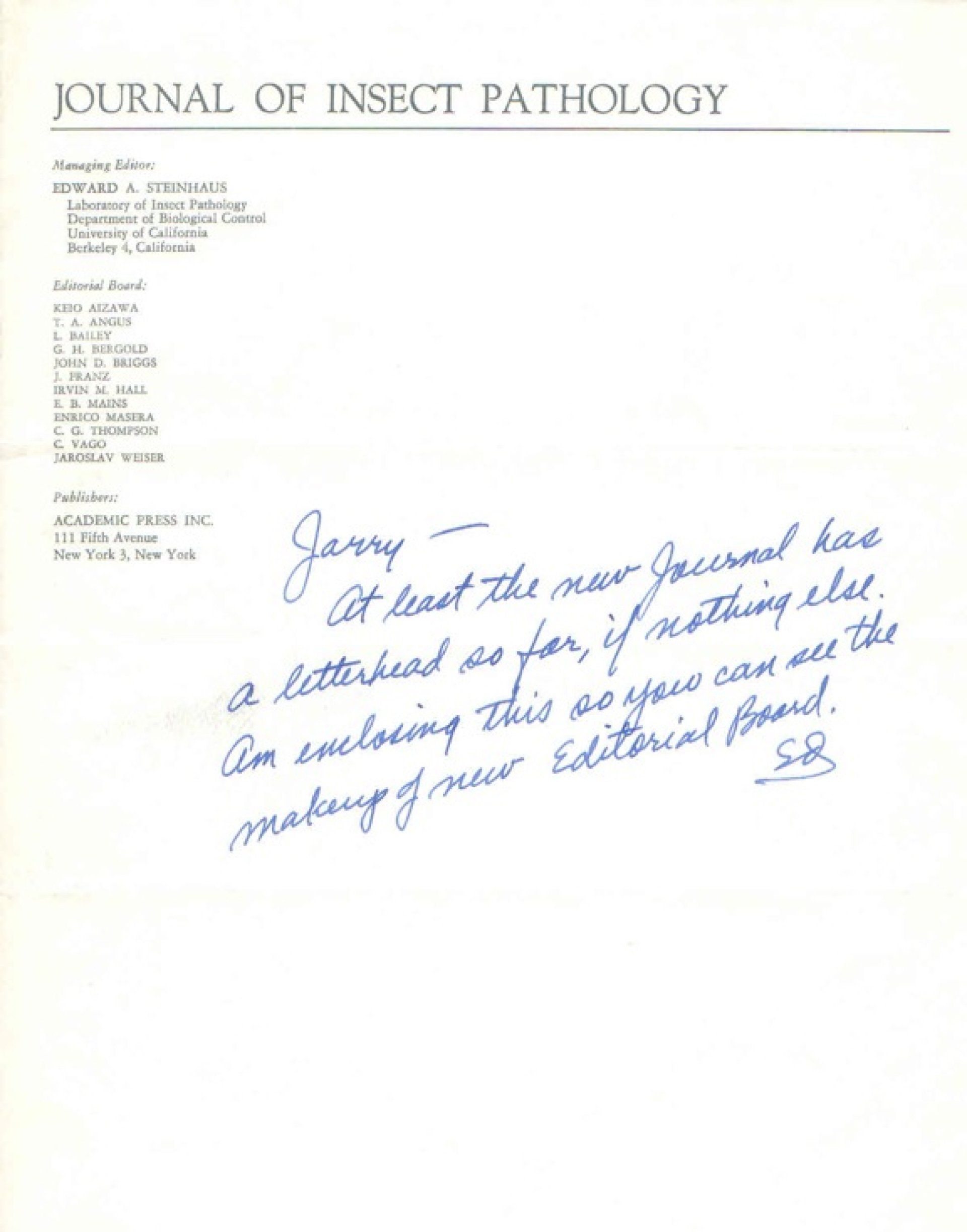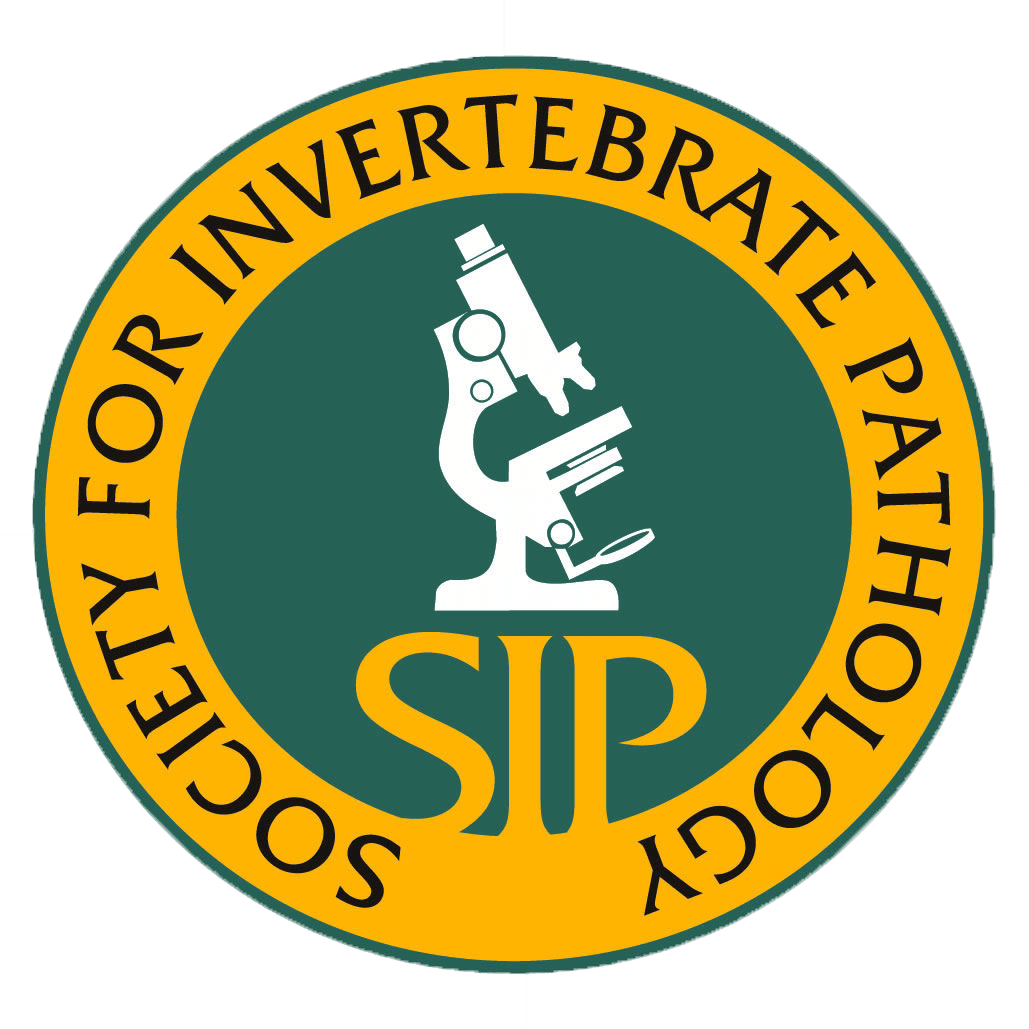History of SIP
History, Timeline
The following meetings and events involving invertebrate pathology led up to the founding of SIP, taken from “Disease in a Minor Chord” (1975) by Edward A. Steinhaus..
1956 - The International Congress of Entomology in Montreal. Gordon Bucher chaired a session on Biological Control using Pathogens, at which Steinhaus met Jaroslav Weiser.
1957 - The 9th Pacific Science Conference in Bangkok at Chulalonkorn University held a session on insect pathogens.
1958 - The First International Conference on Insect Pathology and Biological Control was held in Prague, Czechoslovakia. Weiser, head of the Laboratory of Insect Pathology at the Czechoslovakian Academy of Sciences, organized the meeting. At this meeting many scientists from Western and Eastern Europe and North America met for the first time.
1959- The Entomological Societies of America and Canada met in Detroit, and the entire meeting was dedicated to insect pathology and biological control. Weiser attended as a special guest speaker.
1959 - The Journal of Invertebrate Pathology begins publication, with Steinhaus as editor.
1962 - The World Health Organization Scientific Working Group on Biological Control of Vectors was formed, with Marshall Laird as head.
1963 - WHO hosted a symposium on Culture Procedures for Arthropod Vectors and Biological Control Agents in Gainesville, Florida.
1963 - Two Shellfish Mortality Conferences were held, in New York and Seattle, Washington.
1964 - The American Society for Microbiology held a symposium on microbial diseases of invertebrates, Washington, DC.
1964 - The 12th International Congress of Entomology in London hosted a section on insect pathology, hosted by Lucian Bailey and N.W. Hussey.
1966 - Mauro Martignoni established an insect pathology seminar series at the Entomological Society of America.
1966 - International Colloquium on Insect Pathology and Microbial Control, Wageningen, Netherlands.
1967 - Steinhaus published a proposal in the March issue of the Journal of Invertebrate Pathology that a Society should be formed.
1967 - Albert Sparks and Carl Sindermann sent out a questionnaire to 560 invertebrate pathologists that achieved a mandate to form a society. Most input came from North America, Japan, and Eastern Europe, as there was resistance form the Western European scientists due to the formation of the International Organization of Biological Control.
9 May, 1967 - The Organizing Committee met in Seattle, Washington. Members included Steinhaus, Thomas A. Angus, Arthur M. Heimpel, Mauro E. Martignoni, Carl J. Sindermann, Albert K. Sparks, and Vincent Sprague. Steinhaus was elected as the first President, Sparks as the first Vice-President (President-Elect), and Heimpel was elected the first Treasurer. Dues included: Founding Member ($5), charter and regular member ($4), student member ($2). Emeritus, Honorary and Sustaining Memberships were also established. Heimpel became the first Founding Member. A nominating committee, program committee, and American Institute of Biological Sciences representative were appointed. Later discussions with Constantin Vago led to increased participation by Western Europeans. Dr. Vago was elected Vice-President in the first ballot election.
20 December, 1967 - The first SIP Newsletter was published.
1968 - The Journal of Invertebrate Pathology stated it was “Published under the auspices of the Society for Invertebrate Pathology”
3-7 September, 1968 - The first SIP meeting was held at Ohio State University, Columbus, Ohio, in conjunction with AIBS. John Briggs was the host.


History, from Conception to Birth
(By Albert K. Sparks, the second President of SIP, who hosted the founding meeting in 1967 in Seattle, Washington. Published in the June, 1992 issue of the SIP Newsletter Vol. 24, No. 2, pp. 11-13.)
Subsequent to an informal discussion with several oyster pathologists in early 1967 relative to the current status and future potential of oyster pathology in particular and invertebrate pathology in general, I called Edward A. Steinhaus and asked him if he thought there was any interest on the part of insect pathologists in forming a society of invertebrate pathology combining the disciplines of insect pathology and oyster pathology.
I knew Ed Steinhaus because he had appointed me, along with Fred Bang, to the Editorial Board of the Journal of Invertebrate Pathology when its name was changed from the Journal of Insect Pathology in 1965. I’m sure he did so because I had published several papers in the journal prior to the name change. Although I had not met Steinhaus in person, we had had numerous telephone conversations in addition to written correspondence on JIP editorial business.
Ed Steinhaus was almost exuberant at my question. “I’ve been trying to do this for years” he said, “but I’ve been talking to the wrong people. I’ve been talking to the insect pathologists and most of them are contented with things just the way they are. I even proposed forming such a society at the 8th International Congress of Comparative Pathology last year in Beirut.”
Excerpts from the talk were published a few weeks later as an editorial in the Journal of Invertebrate Pathology (Vol. 9 No. 1, pp. i-v). Near the end of that editorial was this statement:
“The insect pathologists, currently the most active group of invertebrate pathologists, should join with other invertebrate pathologists to form a truly international society or organization of invertebrate pathology. Such an international society is hereby proposed.”
Thus, through pure serendipity, we oyster pathologists had come up with the precise idea that Ed Steinhaus had proposed at the 8th International Congress of Pathology and in an editorial that was in press at the time of our discussion.
Steinhaus said: “I know personally every insect pathologist in the world and you must know all the oyster pathologists. I’ll work up a questionnaire, send it to you for your approval, and you return it with the name and address of every noninsect invertebrate pathologist you know, I’ll combine the lists and we’ll send them the questionnaire over both our names”.
Ed Steinhaus mailed the questionnaire to 560 individuals, approximately 400 insect pathologists and 160 with interest in the pathology of invertebrates other than insects. The questions asked were:
1. Are you in favor of a truly international society of invertebrate pathology?
2. Should such a society assume the responsibility for holding regular international congresses?
3. As an official organ of the society would you favor:
a) Journal of Invertebrate Pathology?
b) Publishing in English with summaries in other languages?
c) Publishing entire articles in one of several languages?
d) Some journal other than (a)?
e) Which “other” journal?
f) An entirely new journal?
g) No journal of any type?
4. Whom would you nominate as members of an organizing committee?
When Steinhaus had received 248 of the returned questionnaires, 44% of those sent out, I flew to Irvine for the opening and tabulating of the returns. The response was overwhelmingly favorable, 229 in favor and 19 not in favor (12 of which were from the same laboratory). As an official organ of the society, 202 favored the Journal of Invertebrate Pathology and only 3 voted no, 3 favored some journal other than JIP, 6 were in favor of an entirely new journal and 4 favored no journal of any type. A total of 98 individuals were nominated and 15 received 10 or more votes for the organizing committee.
We decided to form an Organizing Committee composed of the seven individuals with the most nominations. Steinhaus, because of his preeminent status in insect pathology, received the most votes; the six others receiving the largest number of nominations were Thomas A. Angus, Arthur M. Heimpel, Mauro E. Martignoni, Carl J. Sindermann, Albert K. Sparks and Victor Sprague.
Because I was hosting an Oyster Pathology Conference at the University of Washington’s College of Fisheries in early May, at which Carl Sindermann and Victor Sprague would also be present, it was decided to hold the organizing meeting in Seattle concurrent with the oyster pathology meeting.
Steinhaus and I drafted a report on the results of the questionnaire, but before it was published in June, the Organizing Committee met on May 9, 1967 in the University of Washington College of Fisheries. All members of the Organizing Committee were present and Thomas C. Cheng attended as a non-voting observer. With Ed serving as chairman, the committee, by unanimous vote, created the Society for Invertebrate Pathology. The Organizing Committee then elected Edward A. Steinhaus president, Albert K. Sparks vice-president, and Art Heimpel secretary-treasurer.
An Editorial Report: “ A Proposed Society for Invertebrate Pathology”, reporting the results of the questionnaire, appeared in the June issue of the Journal of Invertebrate Pathology (Vol. 9 No. 2, p. iii). The actions of the Organizing Committee were published as an Addendum to the editorial report.
The Addendum reported that a new association of invertebrate pathologists, to be known as the Society for Invertebrate Pathology, had been established and listed the officers and the remainder of the Organizing Committee. The addendum further stated that beginning January 1, 1968 the Journal of Invertebrate Pathology would be the official publishing organ of the society. All persons interested in the promotion of invertebrate pathology (i.e. the diseases- infectious and noninfectious- of invertebrate animals) were invited to apply for membership by communicating with the Secretary-Treasurer, Arthur M. Heimpel. Three other items were included: “announcement of the Society’s first general meeting, to be held sometime during 1968, will be made at a later date”, “ratification of a constitution, now being drawn, will be accomplished by mail ballot”, and “the possibility of periodically distributing a mimeographed newsletter is being considered”.
The Society was launched but just barely afloat. Ed, Art, and I chipped in something like $50.00 each for letterhead stationary and other expenses until the Society became solvent from dues. There were originally four types of membership: Founding Members, Charter Members, Regular Members, and Student Members. Ed Steinhaus had asked Mauro Martignoni to draft a constitution and by-laws and all members of the Organizing Committee received several drafts from Mauro for comment. Heimpel was busily mailing out membership applications and Steinhaus and I were frequently on the telephone with a variety of organizing problems. Ed had the correct answer for every question and problem, most of which he had anticipated.
The Society really became viable at the first general meeting held, as promised, in 1968. We decided we were too small to meet independently, so we affiliated with the American Institute of Biological Sciences and joined 22 other societies at the 19th Annual American Institute of Biological Sciences Meeting at Ohio State University in early September.
All members of the Organizing Committee, acting as the Council until Trustees could be elected, spent most of the weekend, including late Saturday an Sunday nights in John Briggs’ home methodically covering each item on Ed Steinhaus’ long agenda.
We finished it up at a scheduled Council Meeting on Monday afternoon prior to the opening session of the first Annual Meeting on Tuesday afternoon, which opened with a Presidential Address.
President Steinhaus’ title was Be Favorable to Bold Beginnings.












